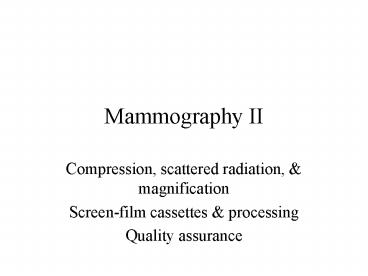Mammography II - PowerPoint PPT Presentation
1 / 33
Title:
Mammography II
Description:
Firm compression reduces overlapping anatomy and decreases tissue thickness of the breast. ... Wax insert composition and 'undegraded' radiograph. Phantom QA ... – PowerPoint PPT presentation
Number of Views:132
Avg rating:3.0/5.0
Title: Mammography II
1
Mammography II
- Compression, scattered radiation, magnification
- Screen-film cassettes processing
- Quality assurance
2
(No Transcript)
3
Compression
- Firm compression reduces overlapping anatomy and
decreases tissue thickness of the breast. This
results in - Fewer scattered x-rays
- Less geometric blurring of anatomic structures
- Lower radiation dose to the breast tissues
- Uniform breast thickness lessens exposure dynamic
range and allows the use of higher contrast film
4
(No Transcript)
5
Compression (cont.)
- Compression paddle should match the size of the
image receptor, be flat and parallel to the
breast support table, and not deflect more than 1
cm at any location when compression is applied - A right-angle edge at the chest wall produces a
flat, uniform breast thickness when compressed
with a force of 10 to 20 newtons (22 to 44 pounds)
6
(No Transcript)
7
Spot compression
- Smaller compression paddle area ( 5 cm diameter)
reduces even further the breast thickness in a
specific area and redistributes the tissue for
improved contrast and anatomic rendition - Valuable in delineating anatomy and achieving
minimum thickness in an area of the breast
presenting with suspicious findings on previous
images
8
Compression of a suspicious are shows no visible
mass
9
Contrast
- Maximum contrast with scatter
10
Scatter
- The amount of scatter in mammography increases
with increasing breast thickness and breast area,
and is relatively constant with kVp - The fraction of scattered radiation in the image
can be reduced by use of antiscatter grids or air
gaps, as well as vigorous compression
11
Scatter depends on breast thickness and field area
12
Antiscatter grid
- Parallel linear grids with a ratio of 41 or 51
are commonly used - Aluminum and carbon fiber are common interspace
materials - Grid frequencies range from 30 to 50 lines/cm for
moving grids, and up to 80 lines/cm for
stationary grids
13
Linear grid (typically 51), cellular grid for 2D
scatter rejection, and the air gap (intrinsic to
magnification procedures)
14
2D copper scatter grid with air interspaces
transmits 87 of primary photons (Argonne
National Labs, 2006)
15
Magnification
- Magnification is achieved by
- Placing a breast support platform to a fixed
position above the detector - Selecting the small focal spot
- Replacing the antiscatter grid with a cassette
holder, and - Using an appropriate compression paddle
16
Geometric magnification
17
Magnification (cont.)
- Advantages of magnification include
- Increased effective resolution of the image
receptor by the magnification factor - Reduction of effective image noise
- Reduction of scattered radiation
- Limitations of magnification include
- Geometric blurring caused by the finite focal
spot size - Small focal spot limits tube current, and extends
exposure times. Even slight breast motion will
cause blurring during the long exposure times
18
Illustration of the need for the 0.1 mm focal
spot in magnification studies
19
Screen-film cassettes
- Most cassettes are made of low-attenuation carbon
fiber and have a single high-definition phosphor
screen used with a single emulsion film - The screen is positioned in the back of the
cassette - Light spread varies with the depth of x-ray
absorption - Most x-rays interact in the layers of the screen
closest to the film, preserving spatial resolution
20
Film-screen system for mammography
21
(No Transcript)
22
Film processor QA
- Must be done daily, prior to first patient use
- Solution levels and temperatures checked
- Base fog must be within 0.03 of baseline
- Mid-density must be within 0.15 of baseline
- Density difference (contrast) must be within
0.15 of baseline
23
Film processor testing
24
(No Transcript)
25
Radiation dosimetry
- Mean glandular dose preferred index since
glandular tissue is most always the site of
carcinogenesis - Speed of screen-film system and film OD preferred
by radiologist are major factors - Should not exceed 3.0 mGy (300 mrad) per film
26
(No Transcript)
27
Mammography phantom
- Used to determine adequacy of overall imaging
system (including film processing) in terms of
detection of subtle radiographic findings, and to
assess reproducibility of image characteristics
(e.g., contrast and optical density) over time
28
(No Transcript)
29
Phantom (cont.)
- Intended to mimic attenuation characteristics of
a standard breast of 4.2 cm compressed
thickness composed of 50 adipose tissue and 50
glandular tissue - Wax insert contains
- 6 cylindrical nylon fibers of decreasing
diameter - 5 simulated calcification groups (Al2O3 specks)
of decreasing size - 5 low contrast disks, of decreasing diameter and
thickness, that simulate masses
30
Wax insert composition and undegraded radiograph
31
(No Transcript)
32
Phantom QA
- Should be done weekly must be done monthly
- Minimum of 4 largest fibers, 3 largest speck
groups, and 3 largest masses must be visible - Number of test objects of each group type visible
in image should not decrease by more than one
half - Background OD should be at least 1.4 and not vary
more than 0.20 from operating level - Density difference due to a 4.0 mm acrylic disc
should be at least 0.40 and not vary more than
0.05 from established operating level
33
Mammographic image of composite phantom































